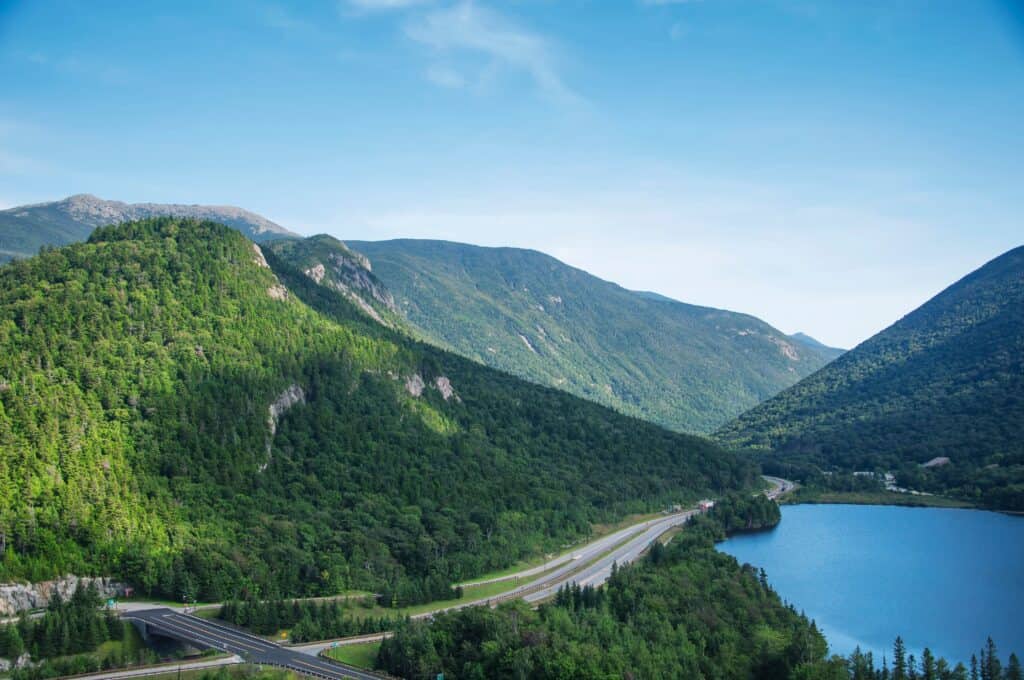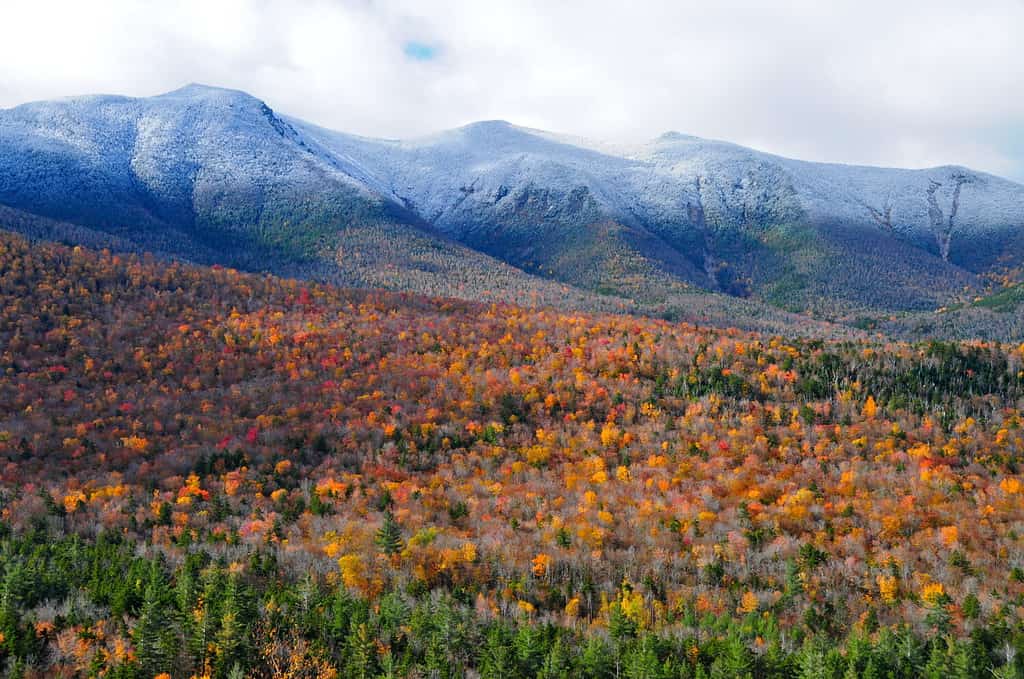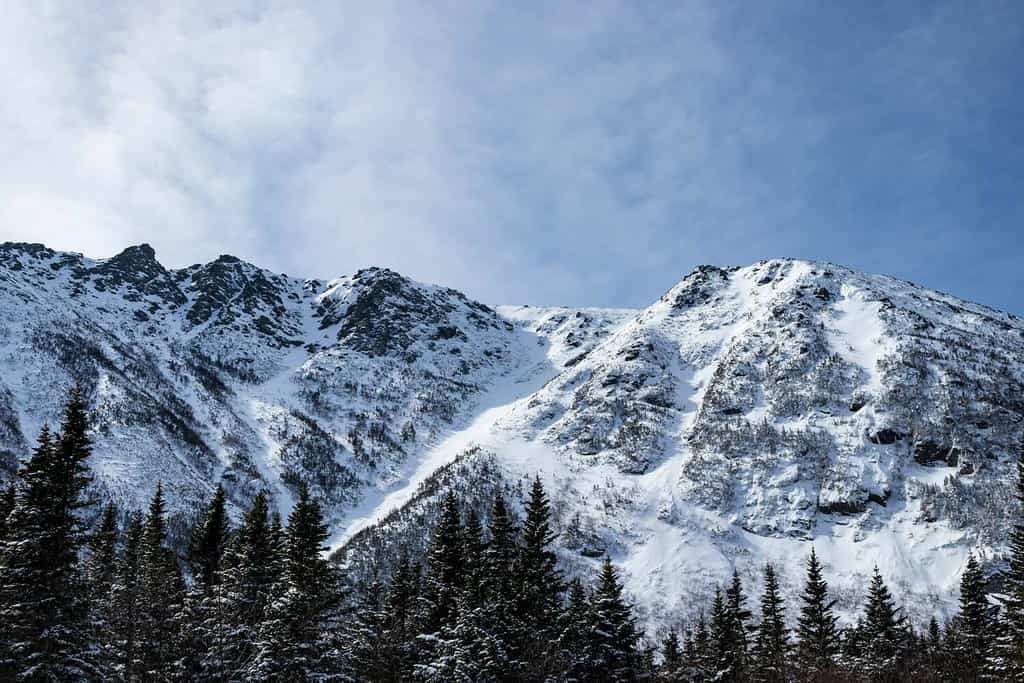New Hampshire’s Mount Lafayette is a lofty peak with epic wildlife and interesting hiking trails. If you’re interested in Mount Lafayette, you’re in the right place! Discover its height compared to nearby peaks, if you can drive there, and what animals prowl around the snowy peak.
How Tall Is Mount Lafayette in New Hampshire?
New Hampshire’s Mount Lafayette is a 5,249 feet (1,600 meters) tall peak in the Eastern United States’ White Mountains. It’s the sixth tallest peak in the White Mountains and the second most prominent in New Hampshire.
Lafayette is named after General Gibert du Motier, Marquis de La Fayette. This French general was an aide to George Washington in the American Revolutionary War and fought in the Continental Army.

Mount Lafayette is the highest point in the Franconia Ridge at 5,249 feet.
©Dan Hanscom/Shutterstock.com
Where Is New Hampshire’s Mount Lafayette?
This lofty peak is situated in the White Mountains, at Franconia Range’s far northern end. Franconia range is a collection of peaks running alongside a mountain pass called Franconia Notch’s eastern side. Mount Lafayette’s peak sits in White Mountain National Forest, with its western face in Franconia’s Notch State Park.
The White Mountains are the most wild and rugged in New England. They cover ¼ of New Hampshire and extend into western Maine. Mount Lafayette and its neighboring peaks are well within driving range of New York City, Montreal, and Boston, and they’re popular tourist spots as a result.
In turn, the White Mountains are part of the enormous Appalachian Mountain range.

The White Mountains are the most rugged in New Hampshire.
©Richard Cavalleri/Shutterstock.com
What Is There to Do on Mount Lafayette?
Five thousand two hundred forty-nine feet tall Mount Lafayette is a hiker and wildlife spotter’s paradise. It boasts numerous well-marked trails with epic waterfalls and AMC huts for overnighters.
A few of the most popular trails include:
Old Brindle Path: The quickest route to the top, this 8.5 mile, 3,600 feet elevation trail meets Greenleaf Trail at the peak. This trail is popular because it’s a ridge line with spectacular views to the summit and over the forests. It passes Greenleaf Hut and Eagle Lake.
Falling Waters Trail: the name gives this 9.6-mile trail away. It’s studded with waterfalls, and as a result, it’s the most popular hike to Mount Lafayette’s peak. Despite its rocky terrain, it’s a busy hike in summer because its waterfalls offer a chance to cool off.
At Mount Lafayette’s Peak, hikers can turn south along the Franconia Ridge Trail, then over Mount Lincoln and Little Haystack. This popular trail descends via the Falling Waters trail.
In summer, these trails are manageable, but in winter, the climate turns very cold. To ascend Mount Lafayette in winter, hikers need crampons and traction-bearing hiking boots to traverse the snow and ice-covered slopes sitting above the tree line.

Beautiful waterfalls flow through the White Mountains range.
©Allard One/Shutterstock.com
Can You Drive up Mount Lafayette?
No, it’s impossible to drive up Mount Lafayette, but its trailhead car parks are large and snow-plowed in winter.
Park in Lafayette campground or both sides of the I-93 at Lafayette Place parking. If the park is full, overflow parking is located on nearby Cannon Mountain with a shuttle to the trailhead. It’s just a few miles further down the road.
New Hampshire’s Highest Peaks
Mount Lafayette is 5,249 feet tall, but it’s not the tallest peak in New Hampshire.
6,288 feet Mount Washington is New Hampshire’s highest peak. It’s the tallest in the Northeastern United States and most prominent to the east of the Mississippi River.
Lafayette is the sixth tallest of the 48 peak mountain series, collectively called the four-thousand footers, established by The Appalachian Mountain Club (AMC).
- Mount Washington: 6,288 feet (1,917 m)
- Mount Adams: 5,774 feet (1,760 m)
- Mount Jefferson: 5,712 feet (1,741 m)
- Mount Monroe: 5,384 feet (1,641 m)
- Mount Madison: 5,367 feet (1,636 m)
- Mount Lafayette: 5,249 feet (1,600 m)
For interest, the shortest 4,000-footer is Mount Tecumseh, which was originally surveyed at 4,003 feet tall, but a 2019 survey returned a height of 3,997 feet.

Mount Washington is New Hampshire’s highest peak.
©Corey T Burns/Shutterstock.com
How Does Mount Lafayette Compare to the Tallest Mountains?
Mount Lafayette tops out at 5,249 feet tall. It’s tall, but not as lofty as the United States’ tallest mountain, Alaska’s 20,310 feet Denali (also called Mount McKinley).
The tallest mountain in Europe is 18,510-foot Mount Elbrus in Russia’s Caucasus Mountains, and the world’s tallest mountain is Mount Everest with a whopping elevation of 29,032 feet.
Do Wildfires Break Out on Mount Lafayette?
Wildfire occasionally breaks out in the White Mountains from spring to fall from human activity or lightning strikes. Still, fire is also used as a tool to manage habitat diversity in the White Mountain National Park.
Before heading to Mount Lafayette, it’s worth checking to ensure minimal wildfire risk. In winter, it’s too cold for wildfires. Instead, check the weather forecast and dress appropriately.
What Wildlife and Plants Live There?
The very peak of Mount Lafayette is barren and windswept rock, so very little wildlife lives on the peak, but the surrounding alpine zone, above the tree line, is home to mat-forming, low-growing sedges, grasses, mosses, lichens, and sedges. Mount Lafayette is home to rare ridge plants, too, such as mountain heath, dwarf cinquefoil, alpine blueberry, and Appalachian fir clubmoss.
Epic wildlife roams on the ascending slopes and throughout the White Mountain Forest Park.
American Black Bear
American black bears are fearsome wild animals that live throughout the White Mountain National Forest. Food scraps and backpacks are tempting to these omnivorous animals, which were once shy but have become accustomed to humans. Feeding bears is prohibited here. If you encounter one, walk away slowly.
Black bears eat moose, deer, nuts, berries, roots, and hiker’s picnics. They pose a danger to humans due to their vast size, speed, and strength. They are more than capable of outrunning a human.

It’s illegal to feed wild black bears on Mount Lafayette.
©Ghost Bear/Shutterstock.com
Bobcat
Shy bobcats rarely make an appearance on Mount Lafayette but live there and prey on small mammals, birds, and reptiles. Two-feet-tall bobcats are not as large as mountain lions (which went extinct in New Hampshire during the 1800s). They have distinct bobbed tails, hence their name, brown fur with black spots, and tufted ears.
Nocturnal to crepuscular bobcats hunt in the early mornings, evenings, and overnight. They are excellent climbers and swimmers but are usually spotted resting in tree branches or rocky ledges.
White-tailed Deer
Common around Mount Lafayette and the White Mountain National Forest, white-tailed deer are reddish-brown, but their tails have white undersides, that flick up to warn herd members of danger.
On Mount Lafayette’s slopes, white-tailed deer eat acorns, beechnuts, green plants, and woody vegetation. Adults consume 5-9 pounds of food each day.
Moose
In the early 1900s, the moose population here was all but wiped out by overhunting and loss of habitat, but conservation efforts have led to a rise in numbers. Massive moose can reach 1,000 pounds but only eat grass, twigs, and aquatic vegetation. It’s a surprising fact that moose are good swimmers and can dive to pick out the choicest water weeds.
New Hampshire is their southernmost range in North America. They’re so popular there that moose spotting tours run each day during summer.
Bald Eagle
A symbol of the United States’ wilderness and freedom, the bald eagle lives around Mount Lafayette and the White Mountains, gliding over water to grab fish with their six-inch-long talons.
This incredible bird is brown with a white head (hence the bald name) with an eight-foot-wide wingspan. Juveniles take time to develop their parents’ sleek exterior. They remain dark brown and gangly for at least a year.
From the 1940s to the 1980s, bald eagle numbers severely dropped throughout New England, but the management of pesticide DDT has allowed a steady population rebuild.

Bald eagle numbers are rising across New England.
©Wirestock/ via Getty Images
How Tall is Mount Lafayette: Recap
So, we’ve learned that Mount Lafayette in the White Mountain Range is 5,249 feet tall. It’s the sixth tallest peak in the White Mountains and home to excellent hiking trails all year round. Black bears, bald eagles, bobcats, and white deer take advantage of this rugged but accessible terrain.
The photo featured at the top of this post is © Dan Hanscom/Shutterstock.com
Thank you for reading! Have some feedback for us? Contact the AZ Animals editorial team.






